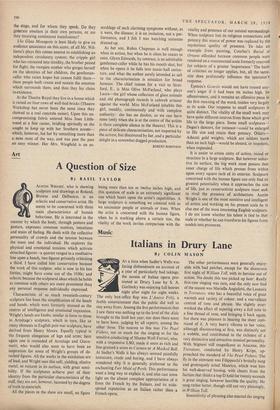Art
A Question of Size
By BASIL
TAYLOR AUSTIN WRIGHT, who is showing sculpture and drawings at Roland, Browse and Delbanco, is an eclectic and conservative artist. He seems to be concerned with three main characteristics of human behaviour. He is interested in the manner by which The body, through posture and gesture, expresses common motives, intentions and states of feeling. He deals with the collective personality of crowds and the tension between the mass and the individual. He explores the physical and emotional tensions which activate detached figures—a quartet ranged in a meditative line upon a beach, two figures privately criticising a third. I have called him conservative because the work of this sculptor, who is now in his late forties, might have come out of the 1930s; and eclectic because the sculptural ideas which he holds in common with others are more prominent than any personal response individually expressed.
Characteristic of so much twentieth-century sculpture has been the simplification of the heads and hands, which were formerly stressed as the centres of intelligence and emotional 'expression. Wright's heads are knobs, similar in form to those in Armitage's sculpture, which in turn, like so many elements in English post-war sculpture, have derived from Henry Moore. Equally typical is the frequent elongation of legs and arms; here again one is reminded of Armitage and Giaco- metti, who would also seem to have been an inspiration for some of Wright's groups of de- tached figures. All the works in the exhibition are of lead, and Wright uses this soft, yielding, elusive metal, so reticent in its surface, with great sensi- bility. If the sculptures achieve part of their identity from the particular characteristics of the stuff, they are not, however, haunted by the dogma of truth to materials.
All the pieces in the show are small, no figure being more than ten or twelve inches high, and this question of scale is an extremely significant one which bears upon the artist's capabilities. A large sculpture is something we contend with as we encounter people or animals or trees. When the artist is concerned with the human figure, when he is working above a certain size, the vitality of the work invites comparison with the vitality and presence of our natural surroundings. When sculpture lost its religious connections and potency this source of power was replaced by the mysterious quality of presence. To take an example from painting, Courbet's Burial at Ornans offended because common people were rendered on a monumental scale formerly reserved for subjects of a greater 'importance.' The basis of criticism no longer applies, but, all the same, size does profoundly influence the spectator's response.
Epstein's Genesis would not have roused any- one's anger if it had been six inches high. Its offensiveness, and it remains an offensive piece in the first meaning of the word, resides very largely in its scale. Our response to small sculptures is quite distinct. The vitality of the small work may have quite different sources from those which give life to the large piece. Some small sculptures- Degas's dancers, for instance—could be enlarged to life size and retain their potency. Others— Ashanti gold weights, which are seldom more than an inch high—would be absurd, or impotent, when expanded.
It is easier to attain unity of action, mood or structure in a large sculpture. But however seduc- tive its surface, the big work must possess that inner charge of life which presses from within upon every square inch of its exterior. Sculpture concerned with the human figure can only find its greatest potentiality when it approaches the size of life, just as constructivist sculpture must seek to rival the presence of architecture. Austin Wright is one of the most sensitive and intelligent of artists and working on his present scale he is also one of the most interesting English sculptors. 1 do not know whether his talent is tied to that scale or whether he can transform his figures from models into presences.










































 Previous page
Previous page